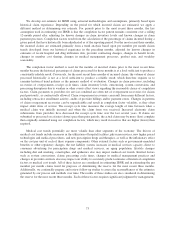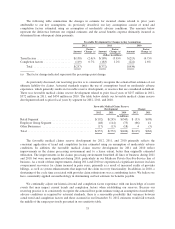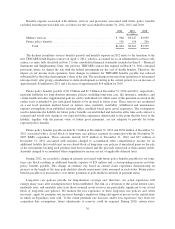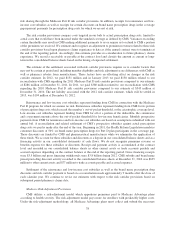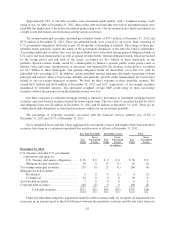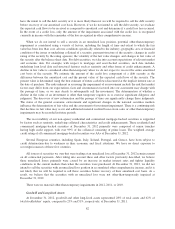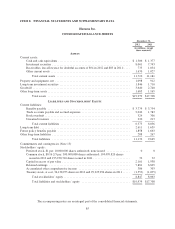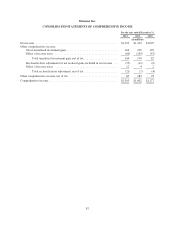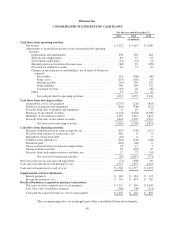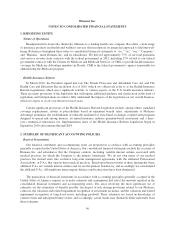Humana 2012 Annual Report Download - page 93
Download and view the complete annual report
Please find page 93 of the 2012 Humana annual report below. You can navigate through the pages in the report by either clicking on the pages listed below, or by using the keyword search tool below to find specific information within the annual report.We are required to test at least annually for impairment at a level of reporting referred to as the reporting
unit, and more frequently if adverse events or changes in circumstances indicate that the asset may be impaired.
A reporting unit either is our operating segments or one level below the operating segments, referred to as a
component, which comprise our reportable segments. A component is considered a reporting unit if the
component constitutes a business for which discrete financial information is available that is regularly reviewed
by management. We are required to aggregate the components of an operating segment into one reporting unit if
they have similar economic characteristics. Goodwill is assigned to the reporting unit that is expected to benefit
from a specific acquisition.
We use a two-step process to review goodwill for impairment. The first step is a screen for potential
impairment, and the second step measures the amount of impairment, if any. Our strategy, long-range business
plan, and annual planning process support our goodwill impairment tests. These tests are performed, at a
minimum, annually in the fourth quarter, and are based on an evaluation of future discounted cash flows. We rely
on this discounted cash flow analysis to determine fair value. However outcomes from the discounted cash flow
analysis are compared to other market approach valuation methodologies for reasonableness. We use discount
rates that correspond to a market-based weighted-average cost of capital and terminal growth rates that
correspond to long-term growth prospects, consistent with the long-term inflation rate. Key assumptions in our
cash flow projections, including changes in membership, premium yields, medical and operating cost trends, and
certain government contract extensions, are consistent with those utilized in our long-range business plan and
annual planning process. If these assumptions differ from actual, including the impact of the ultimate outcome of
the Health Insurance Reform Legislation, the estimates underlying our goodwill impairment tests could be
adversely affected. Goodwill impairment tests completed in each of the last three years did not result in an
impairment loss. The fair value of our reporting units with significant goodwill exceeded carrying amounts by a
substantial margin. A 100 basis point increase in the discount rate would not have a significant impact on the
amount of margin for any of our reporting units with significant goodwill.
Beginning with 2012, we are allowed to first assess qualitative factors to determine whether it is necessary
to perform the two-step quantitative goodwill impairment test. We did not elect to use the qualitative approach in
2012.
Long-lived assets consist of property and equipment and other finite-lived intangible assets. These assets are
depreciated or amortized over their estimated useful life, and are subject to impairment reviews. We periodically
review long-lived assets whenever adverse events or changes in circumstances indicate the carrying value of the
asset may not be recoverable. In assessing recoverability, we must make assumptions regarding estimated future
cash flows and other factors to determine if an impairment loss may exist, and, if so, estimate fair value. We also
must estimate and make assumptions regarding the useful life we assign to our long-lived assets. If these
estimates or their related assumptions change in the future, we may be required to record impairment losses or
change the useful life, including accelerating depreciation or amortization for these assets. There were no
material impairment losses in the last three years.
ITEM 7A. QUANTITATIVE AND QUALITATIVE DISCLOSURES ABOUT MARKET RISK
Our earnings and financial position are exposed to financial market risk, including those resulting from
changes in interest rates.
The level of our pretax earnings is subject to market risk due to changes in interest rates and the resulting
impact on investment income and interest expense. Prior to 2009, under interest rate swap agreements, we
exchanged the fixed interest rate under all of our senior notes for a variable interest rate based on LIBOR using
interest rate swap agreements. We terminated all of our interest rate swap agreements in 2008. We may re-enter
into interest rate swap agreements in the future depending on market conditions and other factors. Amounts
borrowed under the revolving credit portion of our $1.0 billion unsecured revolving credit agreement bear
interest at either LIBOR plus a spread or the base rate plus a spread. There were no borrowings outstanding under
our credit agreement at December 31, 2012 or December 31, 2011.
83


